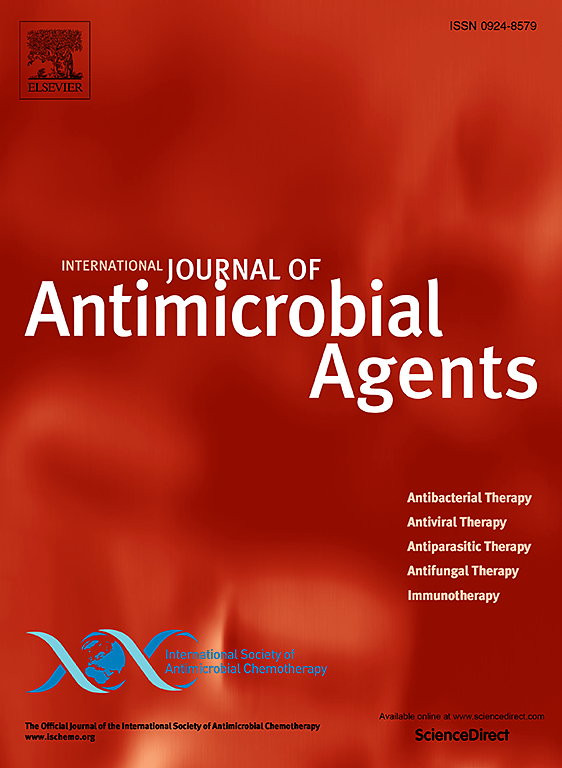Emergence of carbapenem‐resistant Citrobacter spp. across human, animal, and water environments in China
IF 4.9
2区 医学
Q1 INFECTIOUS DISEASES
International Journal of Antimicrobial Agents
Pub Date : 2025-02-12
DOI:10.1016/j.ijantimicag.2025.107463
引用次数: 0
Abstract
Objective
With the rise of carbapenem-resistant Citrobacter spp. (CRC), it is essential to investigate their distribution and resistance characteristics across diverse ecological niches. This study aims to collect CRCs from humans, animals, and water environments to analyze their epidemiology, genetic characteristics, and resistance mechanisms, providing insights into transmission dynamics.
Methods
CRCs were isolated from different samples using methods including filtration, enrichment, screening, and purification. Antimicrobial susceptibility tests were conducted using the broth microdilution method. Transconjugation experiments were performed through filter mating. Whole genome sequencing and bioinformatics analysis were carried out to analyze genomic features of CRCs.
Results
Total of 171 CRCs were isolated from diverse Chinese provinces between 2016 and 2023. All strains are classified into seven Citrobacter species. Citrobacter freundii is the most common (76.02%), with ST116 and ST22 being the predominant strains. Among all strains, 63.16% carried blaNDM-1, and 41.52% carried blaKPC-2. Hospital wastewater was the primary source of CRCs harbouring two carbapenemase genes, with the most prevalent combination being blaNDM-1 and blaKPC-2 (85.71%, 24/28). All strains showed multi-drug resistance, with over 95% resistant to various carbapenems. Transconjugation experiments showed that carbapenemase genes in the majority of CRCs were located on the plasmids and can be transferred to the recipient strains. Phylogenetic analysis displayed that clonal transmission was observed among a few CRCs.
Conclusions
Multiple mobile genetic elements mediate the spread and prevalence of carbapenem resistance in Citrobacter spp. Monitoring carbapenemase genes and CRCs across ecological niches is needed to controlling carbapenem resistance, particularly in high-risk sources like hospital wastewater.

耐碳青霉烯柠檬酸杆菌在中国人类、动物和水环境中的出现。
近年来,耐碳青霉烯柠檬酸杆菌(CRC)的数量呈上升趋势。在本研究中,我们收集了人类、动物和水环境中的crc,以研究其流行病学分布和耐药性特征。2016年至2023年,在中国不同省份共分离出171例crc。所有菌株分为7种Citrobacter,其中以C. freundii最常见(76.02%),ST116和ST22为优势菌株。63.16%的菌株携带blaNDM-1, 41.52%的菌株携带blaKPC-2。医院废水是携带两种碳青霉烯酶基因的crc的主要来源,以blaNDM-1和blaKPC-2组合最为常见(85.71%,24/28)。所有菌株均显示多重耐药,对多种碳青霉烯类药物的耐药率均在95%以上。转偶联实验表明,大多数crc中的碳青霉烯酶基因位于质粒上,可以转移到受体菌株中。根据系统发育分析,在少数CRCs中观察到克隆传播。多个可移动遗传因子介导了柠檬酸杆菌对碳青霉烯耐药的传播和流行。
本文章由计算机程序翻译,如有差异,请以英文原文为准。
求助全文
约1分钟内获得全文
求助全文
来源期刊
CiteScore
21.60
自引率
0.90%
发文量
176
审稿时长
36 days
期刊介绍:
The International Journal of Antimicrobial Agents is a peer-reviewed publication offering comprehensive and current reference information on the physical, pharmacological, in vitro, and clinical properties of individual antimicrobial agents, covering antiviral, antiparasitic, antibacterial, and antifungal agents. The journal not only communicates new trends and developments through authoritative review articles but also addresses the critical issue of antimicrobial resistance, both in hospital and community settings. Published content includes solicited reviews by leading experts and high-quality original research papers in the specified fields.

 求助内容:
求助内容: 应助结果提醒方式:
应助结果提醒方式:


